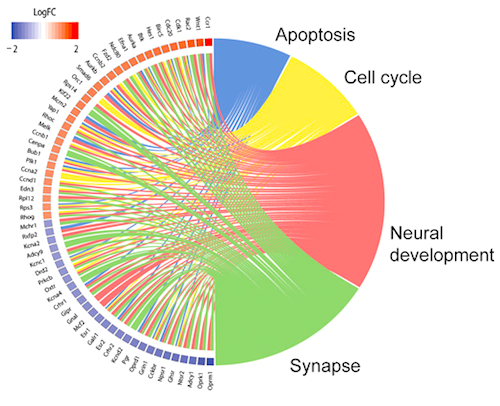|
|
Developmental Biology - Immune System
Zika Birth Abnormalities Linked to Mom's Malnutrition
The severity of Zika deformities in babies is shown to be affected by a mother"s own malnutrition...
Congenital Zika Syndrome (CZS) refers to a collection of developmental malformations associated with congenital infection by the Zika virus (ZIKV).
This includes devastating conditions with a huge impact on that individual's entire life. One being a small head (microcephaly) and unfolded brains (lissencephaly), eye abnormalities, enlarged ventricles in the heart, and a lack of brain inner hemisphere connections along with calcifications in parts of the brain, all can also occur.
Brazil has been widely affected by ZIKV, but 75% of CZS have been found in the socio-economically disadvantaged region of the Northeast.
In a new study published in Science, researchers from the University of Oxford and the Federal University of Rio de Janeiro have found this rise in CZS is linked to poor diet in the infants' mothers.
"We knew that areas of Brazil with the lowest socioeconomic status had the highest level of developmental impairment in babies due to CZS...specifically diets poor in protein, which explains why the devastating effects of CZS vary across ZIKV endemic regions."
Zoltán Molnár PhD, Professor, Department of Physiology, Anatomy & Genetics, Oxford University. Molnár has a long-term collaboration with lead author Patricia Garcez, associate professor of the Federal University of Rio de Janeiro Brazil.
The link between Zika virus infection and CZS had been demonstrated in previous studies, helping researchers understand how the infection affects development of blood vessels. Using a mouse model, the current study also replicated the effects of Zika in mice via a low-protein diet, finding several pathological signs in humans appeared in undernourished mice similarly.
"When we replicated the effects seen in humans with poor diets in mice, we saw similar results. Affects such as placental damage, poor embryonic growth and a reduction in brain size of pups born to undernourished pregnant mice.
"Mouse mothers were clearly less able to fight against ZIKV, a robust and persistent infection in the spleens of undernourished mothers — helping us identify cellular mechanisms responsible for differences in humans. Improving diet alone did not protect against ZIKV infections, but it can determine the severity of the CZS.
"While we need more work to translate these findings into human disease, our mouse model helped us identify significant differences in regulation patterns of key molecular pathways. Particularly as genes identified within developing brains reflect how a poor nutritional status increases adverse effects of ZIKV infection."
Zoltán Molnár PhD.
Abstract
impairments known as congenital Zika syndrome (CZS). The prevalence of this syndrome varies across ZIKV endemic regions, suggesting that its occurrence could depend on cofactors. Here, we evaluate the relevance of protein malnutrition for the emergence of CZS. Epidemiological data from the ZIKV outbreak in the Americas suggest a relationship between undernutrition and cases of microcephaly. To experimentally examine this relationship, we use immunocompetent pregnant mice, which were subjected to protein malnutrition and infected with a Brazilian ZIKV strain. We found that the combination of protein restriction and ZIKV infection leads to severe alterations of placental structure and embryonic body growth, with offspring displaying a reduction in neurogenesis and postnatal brain size. RNA-seq analysis reveals gene expression deregulation required for brain development in infected low-protein progeny. These results suggest that maternal protein malnutrition increases susceptibility to CZS.
Authors
J. Barbeito-Andrés, P. Pezzuto, L. M. Higa, A. A. Dias, J. M. Vasconcelos, T. M. P. Santos, J. C. C. G. Ferreira, R. O. Ferreira, F. F. Dutra, A. D. Rossi, R. V. Barbosa, C. K. N. Amorim, M. P. C. De Souza, L. Chimelli, R. S. Aguiar, P. N. Gonzalez, F. A. Lara, M. C. Castro, Z. Molnár, R. T. Lopes, M. T. Bozza, J. L. S. G. Vianez, C. G. Barbeito, P. Cuervo, M. Bellio, A. Tanur and P. P. Garcez.
Acknowledgments
The study was partially funded by a joint MRC Grant between Professor Zoltán Molnár of the University of Oxford and Associate Professor Patricia Garcez of the Federal University of Rio de Janeiro.
Oxford University"s Medical Sciences Division is one of the largest biomedical research centres in Europe, with over 2,500 people involved in research and more than 2,800 students. The University is rated the best in the world for medicine and life sciences, and it is home to the UK"s top-ranked medical school. It has one of the largest clinical study portfolios in the UK and great expertise in taking discoveries from the lab into the clinic. Partnerships with the local NHS Trusts enable patients to benefit from close links between medical research and healthcare delivery.
Return to top of page.
| |
|
Jan 23 2020 Fetal Timeline Maternal Timeline News
 LP and congenital ZIKV infection gene expression deregulated in embryonic brains. (A) Pathways reflecting biological processes that are deregulated in the LP/ZIKV compared to Co/ZIKV after RNA-seq analyses. Only those with significant differences are presented. (B) Circos plot showing the 60 hub genes, most (RED) and least (BLUE) expressed in LP/ZIKV (as compared to Co/ZIKV) shared between relevant cell processes. Individual selected genes that are significantly down-regulated (C) or up-regulated (D) in LP/ZIKV in comparison to Co/ZIKV. FC, fold change.
|



